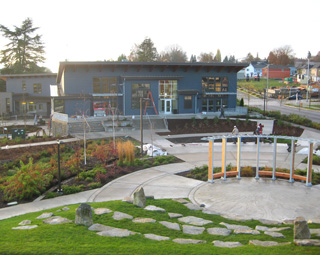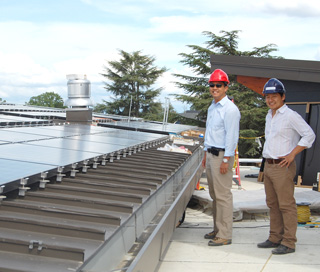|
Subscribe / Renew |
|
|
Contact Us |
|
| ► Subscribe to our Free Weekly Newsletter | |
| home | Welcome, sign in or click here to subscribe. | login |
Environment
| |
November 13, 2009
New Neighborhood House designed as a ‘learning lab'
Journal Staff Reporter
A grand opening will be held on Saturday for Neighborhood House High Point Center, a $13 million project that is targeting LEED gold. The center is expected to have the largest solar array of any building in Washington state.
The 90-kilowatt solar array is being completed in two phases. The first phase, with just under 50 kilowatts, is done. The second phase should be complete by first quarter of next year.
Donors gave $1,000 per solar panel to pay for the system, which should produce almost all of the building's electrical needs, according to press materials.
The 20,000-square-foot center is in Seattle Housing Authority's High Point neighborhood in West Seattle. It was developed by Neighborhood House, a nonprofit that helps refugees, immigrant families and others with limited resources become self sufficient and healthy. It has programs for children, adults and seniors.
Environmental Works was the architect and Berschauer Phillips Construction was general contractor.
Ray Li, director of strategic initiatives for Neighborhood House, said many refugees and immigrants used very little water and energy and created little waste before they came to the United States. But after moving here, they got used to buying more and throwing away more. Neighborhood House, he said, will help educate people about the consequences of their environmental actions.
Real-time information from the solar array will be available on the center's Web site. Computer terminals in the building will have solar data, weather data and information on how the building is performing. Art murals inside the center will teach users about things like water cycles. A solar panel display will draw attention to solar use. A see-through wall section allows people to watch the building's mechanical systems.
Li said the center's community is generally left out of environmental conversations at the local, state and federal level, so the center staff decided to focus on both social justice and environmental justice through the building itself.
“The idea was to make this a learning lab for the community,” he said. “They are constantly surrounded by messages that talk about the environment and their interaction with the environment.”
Neighborhood House conducted interviews with people from seven different cultures about their use of resources before and after coming to America. The translated interviews are available on the center's Web site.
The building has three levels, with offices, classrooms and conference space. Neighborhood House will use 55 percent of the building. The Seattle Housing Authority manages the master lease and will sublease the rest of the space to other community partners, such as the YMCA.
Green features in the building include a ground source heat pump system with 3.4 miles of tubing and 300 wells. The roof is made of structurally insulated panels. The center has triple-paned windows, no- or low-VOC paints, sealants and coatings, and 70 percent FSC wood.
Porous concrete helps treat stormwater. Any water not treated on the site makes its way to the High Point detention pond.
There's also a focus on automatic systems. The HVAC system is connected to windows and won't turn on if any window is left open. The building is oriented toward the sun and maximizes daylight. When more light is needed inside, a system automatically measures the amount of ambient light and adjusts artificial lights accordingly. In the evening, lights will automatically turn off as low wattage emergency exit lights turn on, though people inside the building can override the system.
Li said the goal of the design was to make the center “a living, breathing building.”
The center is also testing a key card system that automatically lets people enter one section of the building, while keeping the rest locked. Li said this will save on staffing costs.
Li said none of these systems could have been used in the center Neighborhood House built at Rainier Vista in 2004 because they were too expensive. Then, he said, going green would have increased the cost by 30 percent. Today, he said the green improvements cost about $1 million, less than 10 percent of the project cost.
Li this is just the beginning of seeing how green nonprofits can get with their buildings.
“...While it is innovative in 2009 and going above and beyond the call of duty for a green standard, my hope is that in five or 10 years from now, this is bare minimum. This is where you start from,” he said.
The building also challenges the idea of what low income people deserve. Often, Li said low income people live in unhealthy communities and spaces. “This is our push, to challenge that notion.” He said he hopes nonprofits move the federal government to adopt new standards.
The grand opening will be tomorrow. Music, refreshments, speakers and entertainment will run from 1 to 4 p.m. Tours begin at 1 p.m. For more information, contact Peter Wolf at (206) 461-8430 x224 or visit http://www.nhwa.org.
Katie Zemtseff can be
reached by email or by phone
at (206) 622-8272.




